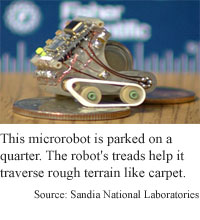
Tiny treads move miniature robots
By Ted Smalley Bowen, Technology Research NewsMobility, or the problem of how to achieve it, presents robot designers with a large obstacle. To get around it, researchers at Sandia National Laboratories have switched from wheels to tank-like treads to propel their smallest robots.
The treads could make the researchers' miniaturization efforts pay off by allowing the tiny robots to traverse such difficult terrain as carpet.
The robots weigh less than an ounce and are equipped with an 8-kilobyte memory module, a temperature sensor, three watch batteries, and a pair of actuators.
"They're nine tenths of an inch long, seven tenths of an inch high and a half an inch wide, and they've got kind of a triangular profile," said Doug Adkins, a mechanical engineer at Sandia. The tiny robots travel about six inches per minute, though some have reached speeds of 10 inches per minute, he said. They can travel about 90 inches on one charge.
The robots are designed to work in hazardous and hard-to-reach settings, like narrow pipes. They could also be used for hazardous waste monitoring and clean-up, and surveillance in volatile situations like hostage rescue missions. The researchers have plans to add a camera, microphone, and chemical sensor to the little robots.
The work builds on the Labs' Mini Autonomous Robot Vehicle (MARV) project, which produced a slightly larger wheeled robot equipped with mostly off-the-shelf components. Adkins and Sandia materials scientist Ed Heller took the MARV concept a step further by shrinking the robots a little more.
The smaller robots are made from widely available un-packaged electronics parts and a form-fitted body that contains cavities for the components. The robot bodies are built using stereolithography, a rapid prototyping technique that uses a laser to harden successive layers of a liquid polymer.
The researchers' next reduction in scale is contingent on finding smaller batteries or using alternate power sources, said Adkins. The batteries account for half of the robot's 7.2-gram weight and one quarter of its volume.
"They won't get any smaller until we get a better battery," he said. "We would like to... build the battery around the robot, rather than... build the robot around the battery," he said.
Powering the robots using solar panels present a size problem, although a small collector could enable the robot to move in spurts, with pauses for re-charging, he said. "To drive these things with today's solar cells, I think we'd need like 30 square centimeters," he said.
Another alternative or supplement to batteries could come from harvesting ambient energy, Adkins said. "There's all sorts of little sources in your room, around outlets and everything else, that give off little [electromagnetic fields]," he said.
The researchers also plan to encase the robots' components to make them more durable and resistant to the elements, Adkins said. "Right now the microprocessor [platforms] are kind of exposed, so we're just going to pod [them over] once we are finished testing them out," he said.
They also plan to add infrared or radio communications to allow the robots to communicate with each other and with their human operators, said Adkins. The MARV robot design used a centrally-controlled communications system that controlled the units via a base station.
"I think the tank treads are quite a useful innovation, although ultimately, legs would give better terrain capability at this small scale," said Ronald Fearing, professor of electrical engineering and computer science at UC Berkeley, who noted that some small-scale wheeled robots are commercially available.
The robots could be used in practical applications in five years, said Adkins. The work was funded by Sandia National Laboratories.
Timeline: 5 years
Funding: Government
TRN Categories: Robotics
Story Type: News
Related Elements: Image
Advertisements:
February 7, 2001
Page One
DNA conducts
DNA induced to superconductivity
Muscles tapped for virtual input
Tiny treads move minuscule robot
Proposal would marry atom and photon

News:
Research News Roundup
Research Watch blog
Features:
View from the High Ground Q&A
How It Works
RSS Feeds:
News
Ad links:
Buy an ad link
| Advertisements:
|
 |
Ad links: Clear History
Buy an ad link
|
TRN
Newswire and Headline Feeds for Web sites
|
© Copyright Technology Research News, LLC 2000-2006. All rights reserved.